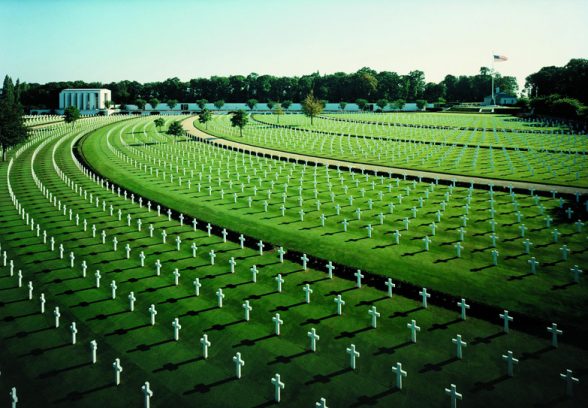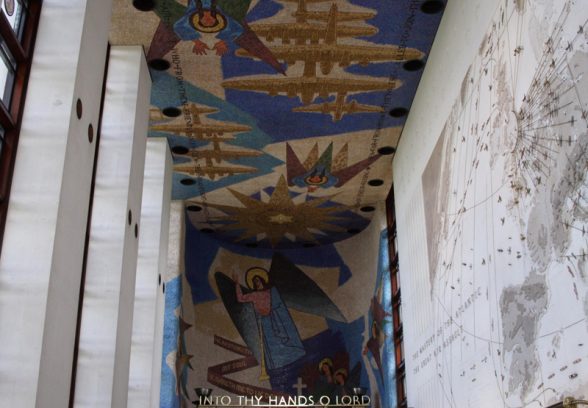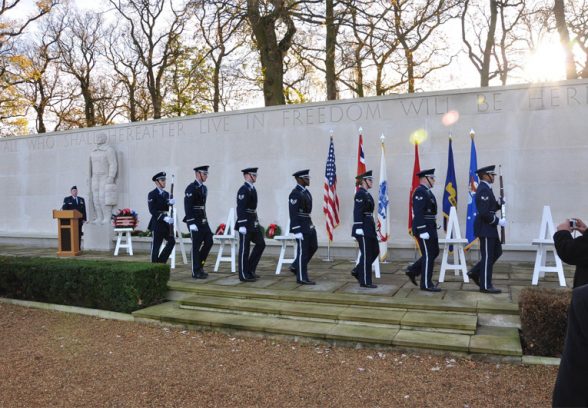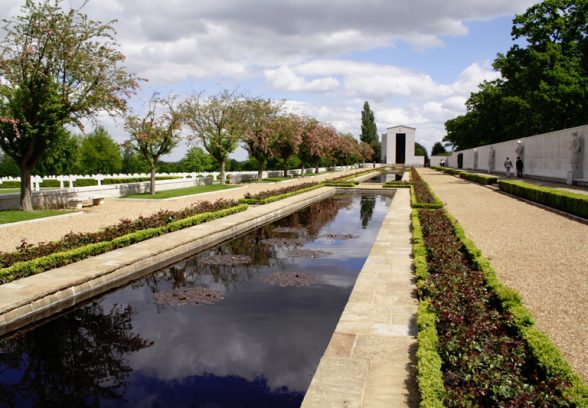This website uses cookies
This website uses cookies to enable it to function properly and to analyse how the website is used. Please click 'Close' to accept and continue using the website.






August 2014 - Cambridge American Cemetery
by India Rose Matharu-Daley
Unlike most cemeteries, the Cambridge American Cemetery, dedicated in 1956, lifts the spirits. Its art, architecture and landscape design communicate glory and gratitude, light and life, patriotism and pride. For the final resting place of 3,812 dead and a memorial to 5,127 missing, death and despair are remarkably absent.
In Britain, a ‘war cemetery’ suggests the austere, solemn, silent schema of the Imperial War Graves Commission. A ‘Stone of Sacrifice’ and ‘Cross of Remembrance’ are its only architectural adornments, erected to communicate bleak loss.
So the American Cemetery, in contrast, can disturb a visitor more familiar with Commonwealth war monuments. Its modern architecture, dramatic landscape design, opulent materials, ubiquitous national symbolism and bold military imagery might initially seem vulgar. These features give the cemetery a distinctly American flavour and create an atmosphere that is more jubilant than mournful. Strangely, the cemetery tends to uplift and inspire, even though its occupants met a horrific demise.
The cemetery is part of a distinctly American tradition of civilian and military cemeteries, according to which, places of burial were not evocative of grief and gloom, but leisure destinations with beautiful gardens. This tradition began with projects such as Green-Wood Cemetery, founded 1838, in Brooklyn, New York and initially laid out by engineer David Bates Douglass. Its verdant foliage and ornamental lakes stretch over the slope of a hill with dramatic views over the East River to Manhattan. By the 1860s, Green-Wood Cemetery was the nation’s most popular tourist attraction after Niagara Falls, receiving 500,000 visitors a year. Thus it served the living as much as the dead.
The USA continued this approach in its military cemeteries. After the Civil War, Congress established a system of formally designed national cemeteries in which fallen Union soldiers were re-interred, making America the first modern nation to give proper burial to the rank-and-file. The seminal example was Arlington National Cemetery, Virginia, where thousands of soldiers lie under white marble headstones in lawned, landscaped gardens with views across the Potomac River to Washington, D.C.
Like Green-Wood and Arlington, Cambridge American Cemetery occupies a hill with a panoramic view. But while the nineteenth-century cemeteries look down on cities, Cambridge faces northeast over the East Anglian countryside towards Ely Cathedral, which is visible on a clear day. Its landscape architects were the Olmsted Brothers, a firm established by Frederick Law Olmsted’s sons. They imposed a fan-shape on the grave plots to take advantage of the vista. This forces visual impetus from a flagstaff at the entrance to the site outwards over the white marble crosses or Stars of David and upwards into the sky. The obvious religious connotations of gazing to heaven aside, the thrust skywards recalls bomber planes taking off from an airfield. From above, the fan-shape, with striations in the form of white gravel paths between the lawned grave plots, appositely recalls submarine or aircraft radar.
At Cambridge, a ‘great mall’ runs eastward from the flagstaff along the site’s southernmost edge. Three reflecting pools in the centre of the mall resemble those of the National Mall in Washington, D.C. A wall inscribed with the names of the missing stretches towards a chapel designed by the Boston architects Perry Shaw and Hepburn, Kehoe and Dean. Its style melding elements of stripped classicism, American art deco and a soft modernism, the chapel suggests both aircraft hangar and Greek temple. On the exterior, five pylons are inscribed with the years of the USA’s official involvement in WWII and a map shows the location of American military bases in Britain. The chapel interior contains a giant mural map of US, British and Canadian military, air and naval operations in Europe. Six smaller maps detail the course of America’s war in the West and the Pacific. At the easternmost end of the chapel is a semi-circular apse with an altar, on which stands a cross and the Tablets of Moses. A mosaic with angels, aircraft, battleships and headstones in a green pasture runs across the length of the ceiling and down the altar wall. The west and north walls are decorated with stained-glass military decorations and state seals.
To those who would consider it inappropriate to depict weaponry in a cemetery for slaughtered soldiers, the American Battle Monuments Commission would say that the maps and models were an honest statement of the nature and aims of the conflict. In this way the cemetery is didactic. It was created with all kinds of visitors in mind: not only immediate relatives who would come to mourn, but the American, and British, citizens who would come after them.
India Rose Matharu-Daley is an undergraduate student of the history of art at St John’s College, Cambridge. She is an admirer of the art of Joan Miró and the architecture of Geoffrey Bawa.
Look for past Buildings of the Month by entering the name of an individual building or architect or browsing the drop down list.

Become a C20 member today and help save our modern design heritage.